2009 BMW 128I COUPE child restraint
[x] Cancel search: child restraintPage 37 of 166
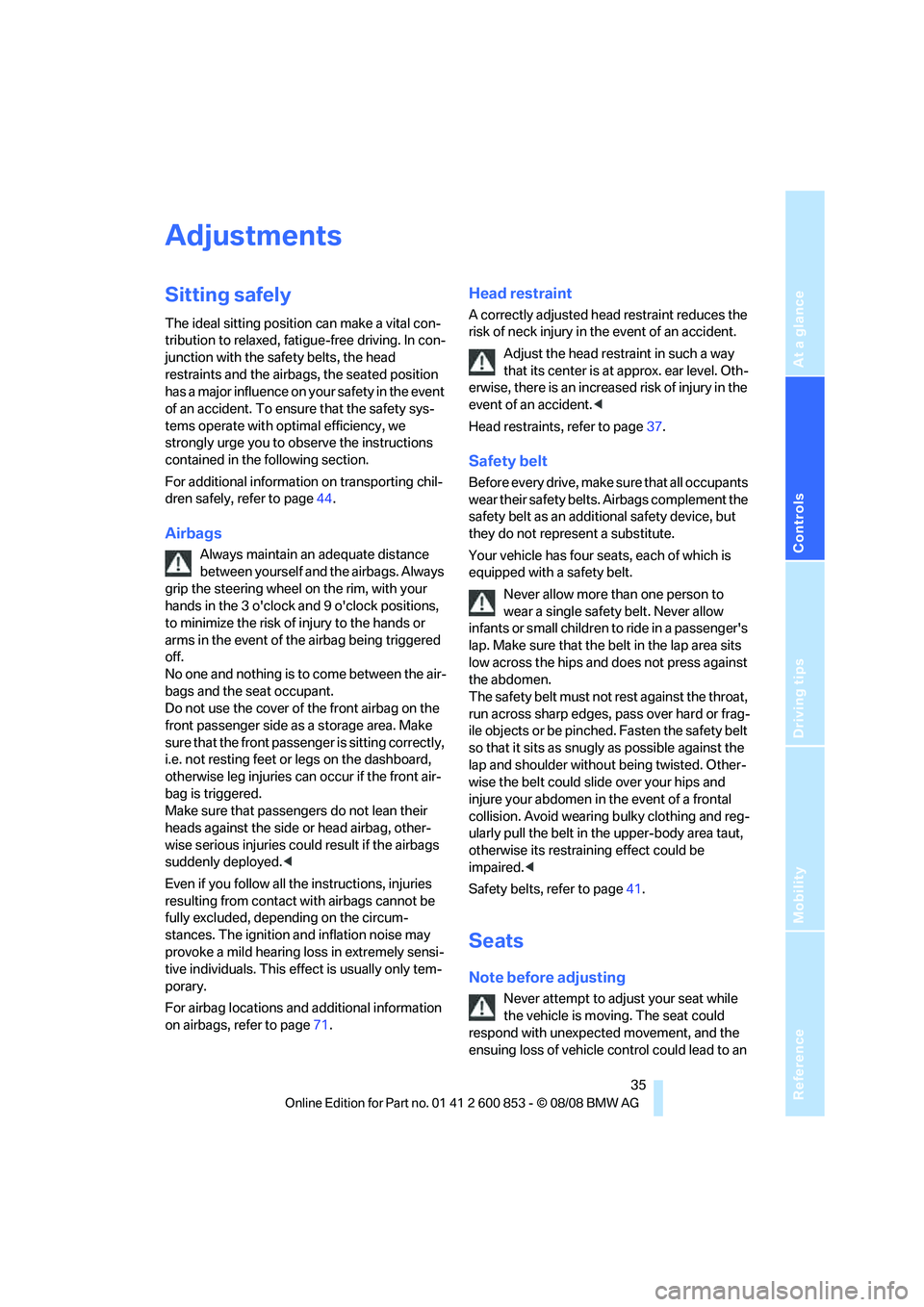
Reference
At a glance
Controls
Driving tips
Mobility
35
Adjustments
Sitting safely
The ideal sitting position can make a vital con-
tribution to relaxed, fatigue-free driving. In con-
junction with the safety belts, the head
restraints and the airbags, the seated position
has a major influence on your safety in the event
of an accident. To ensure that the safety sys-
tems operate with optimal efficiency, we
strongly urge you to observe the instructions
contained in the following section.
For additional information on transporting chil-
dren safely, refer to page44.
Airbags
Always maintain an adequate distance
between yourself and the airbags. Always
grip the steering wheel on the rim, with your
hands in the 3 o'clock and 9 o'clock positions,
to minimize the risk of injury to the hands or
arms in the event of the airbag being triggered
off.
No one and nothing is to come between the air-
bags and the seat occupant.
Do not use the cover of the front airbag on the
front passenger side as a storage area. Make
sure that the front passenger is sitting correctly,
i.e. not resting feet or legs on the dashboard,
otherwise leg injuries can occur if the front air-
bag is triggered.
Make sure that passengers do not lean their
heads against the side or head airbag, other-
wise serious injuries could result if the airbags
suddenly deployed.<
Even if you follow all the instructions, injuries
resulting from contact with airbags cannot be
fully excluded, depending on the circum-
stances. The ignition and inflation noise may
provoke a mild hearing loss in extremely sensi-
tive individuals. This effect is usually only tem-
porary.
For airbag locations and additional information
on airbags, refer to page71.
Head restraint
A correctly adjusted head restraint reduces the
risk of neck injury in the event of an accident.
Adjust the head restraint in such a way
that its center is at approx. ear level. Oth-
erwise, there is an increased risk of injury in the
event of an accident.<
Head restraints, refer to page37.
Safety belt
Before every drive, make sure that all occupants
wear their safety belts. Airbags complement the
safety belt as an additional safety device, but
they do not represent a substitute.
Your vehicle has four seats, each of which is
equipped with a safety belt.
Never allow more than one person to
wear a single safety belt. Never allow
infants or small children to ride in a passenger's
lap. Make sure that the belt in the lap area sits
low across the hips and does not press against
the abdomen.
The safety belt must not rest against the throat,
run across sharp edges, pass over hard or frag-
ile objects or be pinched. Fasten the safety belt
so that it sits as snugly as possible against the
lap and shoulder without being twisted. Other-
wise the belt could slide over your hips and
injure your abdomen in the event of a frontal
collision. Avoid wearing bulky clothing and reg-
ularly pull the belt in the upper-body area taut,
otherwise its restraining effect could be
impaired.<
Safety belts, refer to page41.
Seats
Note before adjusting
Never attempt to adjust your seat while
the vehicle is moving. The seat could
respond with unexpected movement, and the
ensuing loss of vehicle control could lead to an
Page 43 of 166
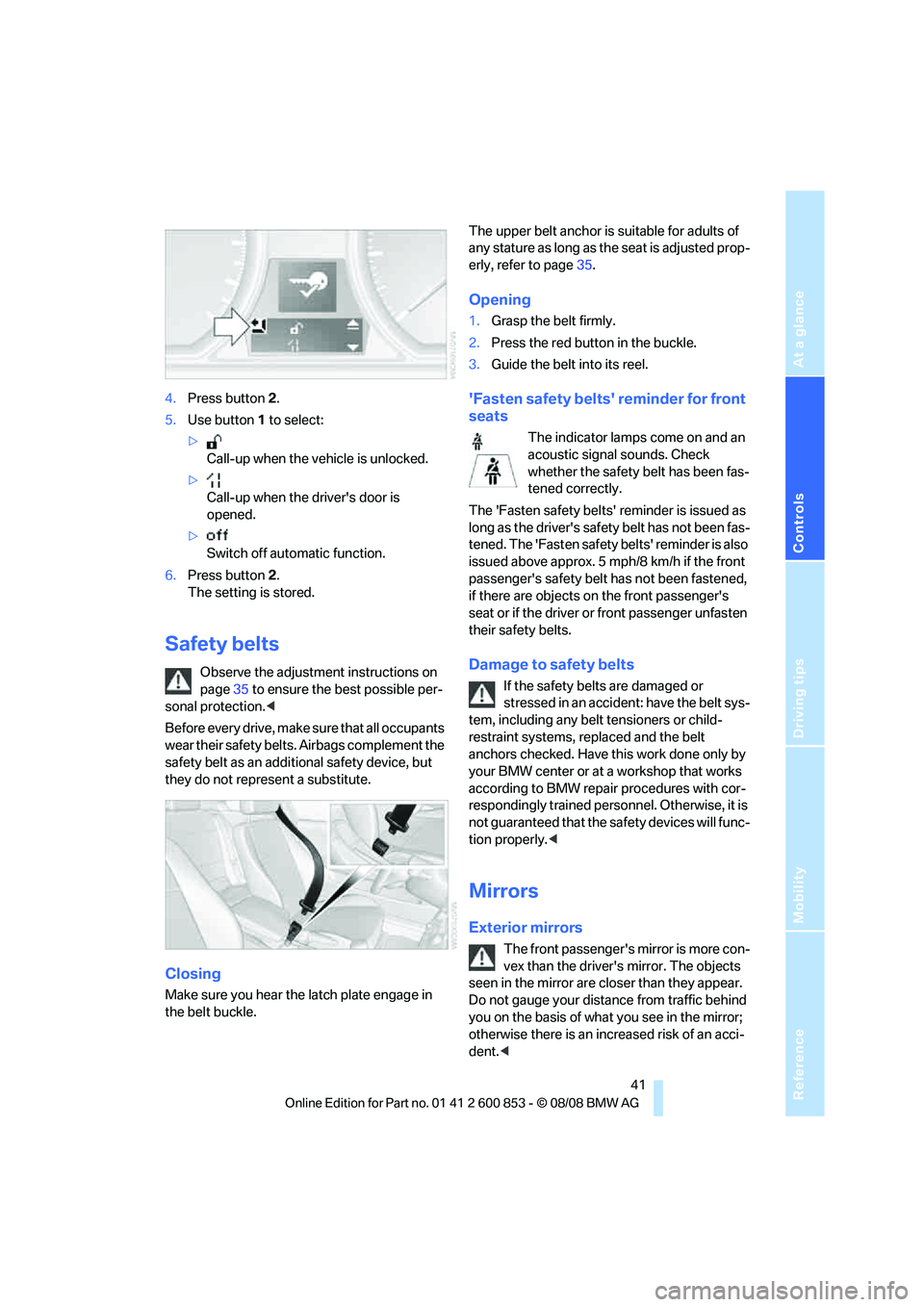
Reference
At a glance
Controls
Driving tips
Mobility
41
4.Press button 2.
5.Use button 1 to select:
>
Call-up when the vehicle is unlocked.
>
Call-up when the driver's door is
opened.
>
Switch off automatic function.
6.Press button 2.
The setting is stored.
Safety belts
Observe the adjustment instructions on
page35 to ensure the best possible per-
sonal protection.<
Before every drive, make sure that all occupants
wear their safety belts. Airbags complement the
safety belt as an additional safety device, but
they do not represent a substitute.
Closing
Make sure you hear the latch plate engage in
the belt buckle.The upper belt anchor is suitable for adults of
any stature as long as the seat is adjusted prop-
erly, refer to page35.
Opening
1.Grasp the belt firmly.
2.Press the red button in the buckle.
3.Guide the belt into its reel.
'Fasten safety belts' reminder for front
seats
The indicator lamps come on and an
acoustic signal sounds. Check
whether the safety belt has been fas-
tened correctly.
The 'Fasten safety belts' reminder is issued as
long as the driver's safety belt has not been fas-
tened. The 'Fasten safety belts' reminder is also
issued above approx. 5 mph/8 km/h if the front
passenger's safety belt has not been fastened,
if there are objects on the front passenger's
seat or if the driver or front passenger unfasten
their safety belts.
Damage to safety belts
If the safety belts are damaged or
stressed in an accident: have the belt sys-
tem, including any belt tensioners or child-
restraint systems, replaced and the belt
anchors checked. Have this work done only by
your BMW center or at a workshop that works
according to BMW repair procedures with cor-
respondingly trained personnel. Otherwise, it is
not guaranteed that the safety devices will func-
tion properly.<
Mirrors
Exterior mirrors
The front passenger's mirror is more con-
vex than the driver's mirror. The objects
seen in the mirror are closer than they appear.
Do not gauge your distance from traffic behind
you on the basis of what you see in the mirror;
otherwise there is an increased risk of an acci-
dent.<
Page 46 of 166
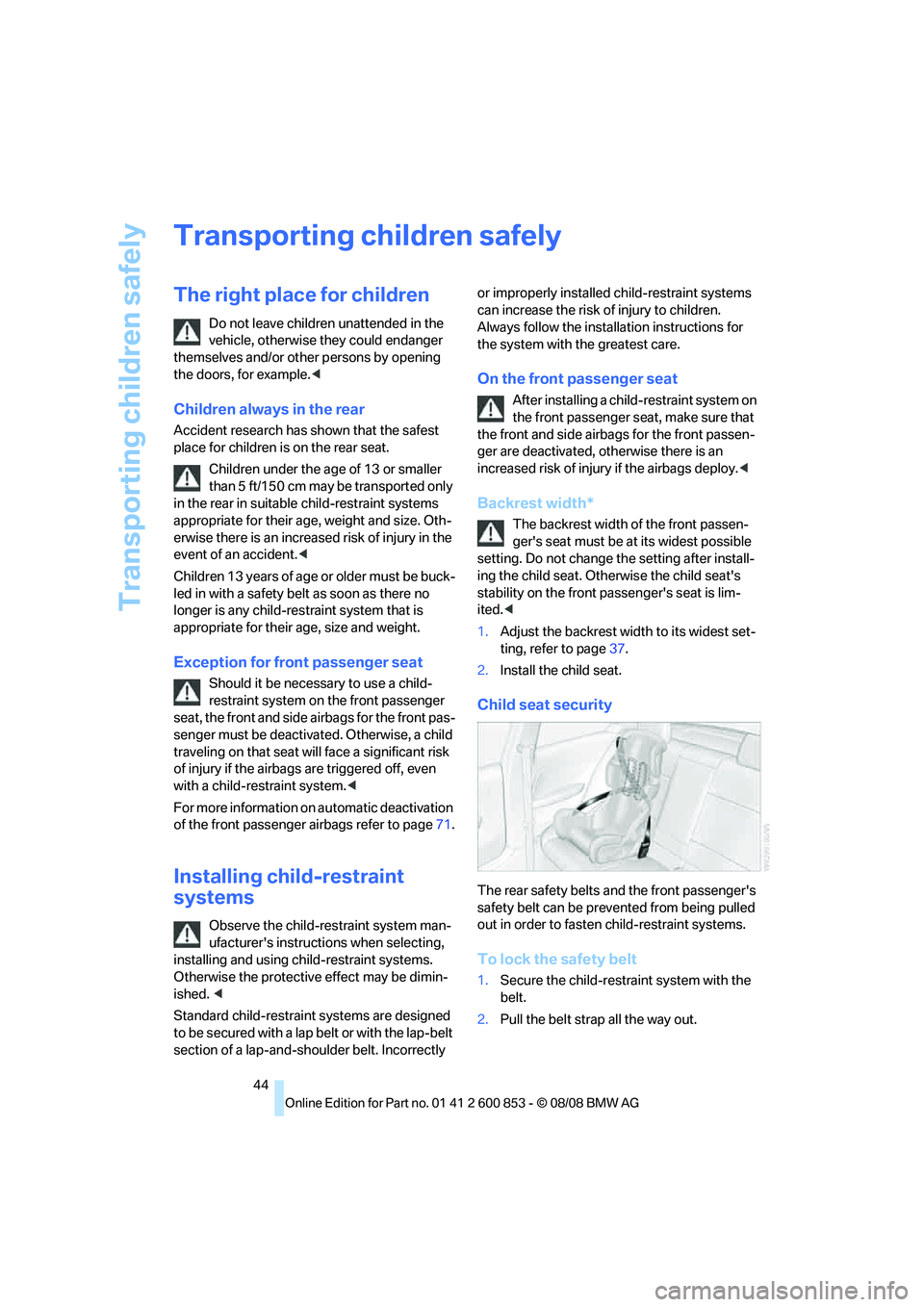
Transporting children safely
44
Transporting children safely
The right place for children
Do not leave children unattended in the
vehicle, otherwise they could endanger
themselves and/or other persons by opening
the doors, for example.<
Children always in the rear
Accident research has shown that the safest
place for children is on the rear seat.
Children under the age of 13 or smaller
than 5 ft/150 cm may be transported only
in the rear in suitable child-restraint systems
appropriate for their age, weight and size. Oth-
erwise there is an increased risk of injury in the
event of an accident.<
Children 13 years of age or older must be buck-
led in with a safety belt as soon as there no
longer is any child-restraint system that is
appropriate for their age, size and weight.
Exception for front passenger seat
Should it be necessary to use a child-
restraint system on the front passenger
seat, the front and side airbags for the front pas-
senger must be deactivated. Otherwise, a child
traveling on that seat will face a significant risk
of injury if the airbags are triggered off, even
with a child-restraint system.<
For more information on automatic deactivation
of the front passenger airbags refer to page71.
Installing child-restraint
systems
Observe the child-restraint system man-
ufacturer's instructions when selecting,
installing and using child-restraint systems.
Otherwise the protective effect may be dimin-
ished. <
Standard child-restraint systems are designed
to be secured with a lap belt or with the lap-belt
section of a lap-and-shoulder belt. Incorrectly or improperly installed child-restraint systems
can increase the risk of injury to children.
Always follow the installation instructions for
the system with the greatest care.
On the front passenger seat
After installing a child-restraint system on
the front passenger seat, make sure that
the front and side airbags for the front passen-
ger are deactivated, otherwise there is an
increased risk of injury if the airbags deploy.<
Backrest width*
The backrest width of the front passen-
ger's seat must be at its widest possible
setting. Do not change the setting after install-
ing the child seat. Otherwise the child seat's
stability on the front passenger's seat is lim-
ited.<
1.Adjust the backrest width to its widest set-
ting, refer to page37.
2.Install the child seat.
Child seat security
The rear safety belts and the front passenger's
safety belt can be prevented from being pulled
out in order to fasten child-restraint systems.
To lock the safety belt
1.Secure the child-restraint system with the
belt.
2.Pull the belt strap all the way out.
Page 47 of 166
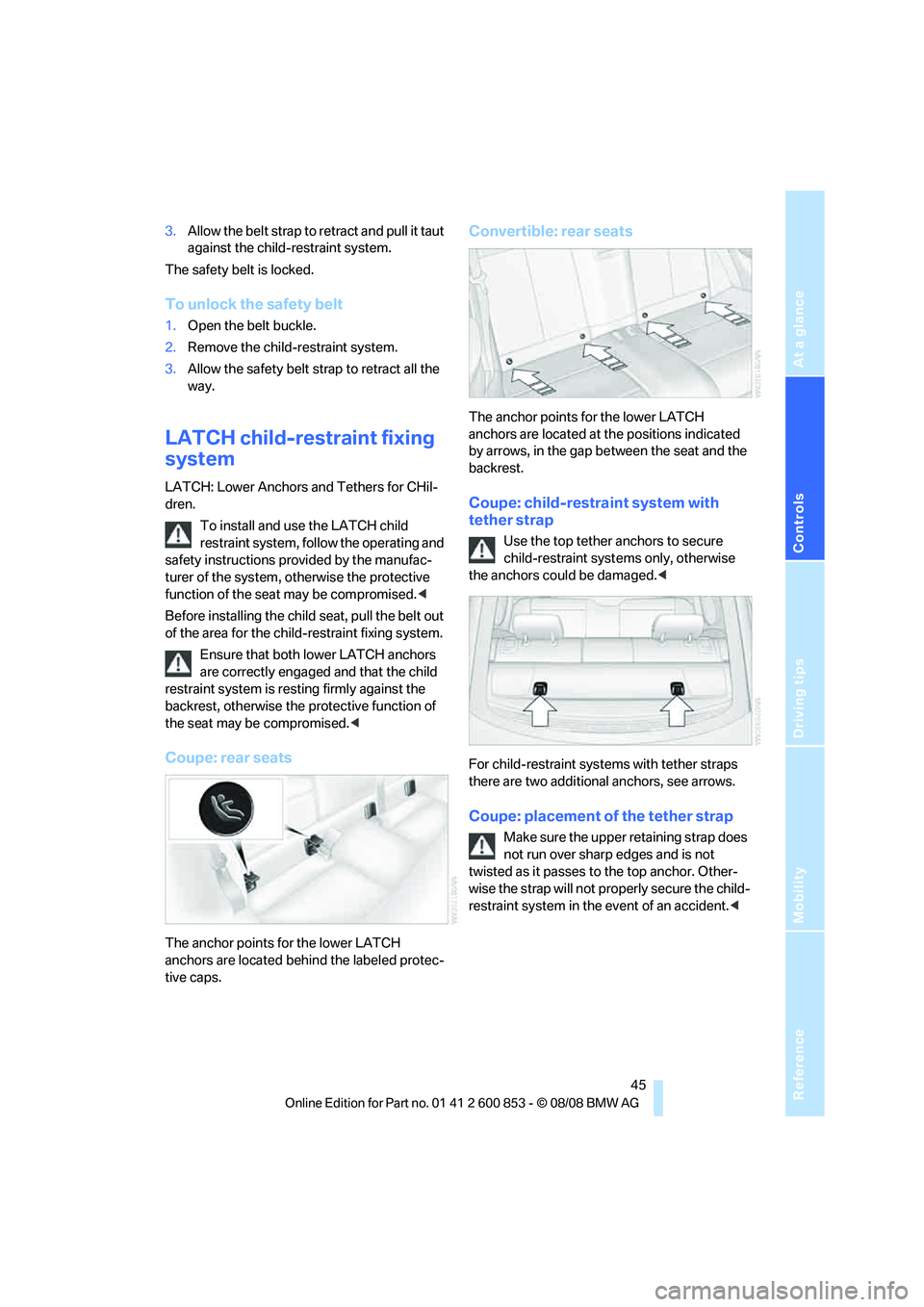
Reference
At a glance
Controls
Driving tips
Mobility
45
3.Allow the belt strap to retract and pull it taut
against the child-restraint system.
The safety belt is locked.
To unlock the safety belt
1.Open the belt buckle.
2.Remove the child-restraint system.
3.Allow the safety belt strap to retract all the
way.
LATCH child-restraint fixing
system
LATCH: Lower Anchors and Tethers for CHil-
dren.
To install and use the LATCH child
restraint system, follow the operating and
safety instructions provided by the manufac-
turer of the system, otherwise the protective
function of the seat may be compromised.<
Before installing the child seat, pull the belt out
of the area for the child-restraint fixing system.
Ensure that both lower LATCH anchors
are correctly engaged and that the child
restraint system is resting firmly against the
backrest, otherwise the protective function of
the seat may be compromised.<
Coupe: rear seats
The anchor points for the lower LATCH
anchors are located behind the labeled protec-
tive caps.
Convertible: rear seats
The anchor points for the lower LATCH
anchors are located at the positions indicated
by arrows, in the gap between the seat and the
backrest.
Coupe: child-restraint system with
tether strap
Use the top tether anchors to secure
child-restraint systems only, otherwise
the anchors could be damaged.<
For child-restraint systems with tether straps
there are two additional anchors, see arrows.
Coupe: placement of the tether strap
Make sure the upper retaining strap does
not run over sharp edges and is not
twisted as it passes to the top anchor. Other-
wise the strap will not properly secure the child-
restraint system in the event of an accident.<
Page 48 of 166
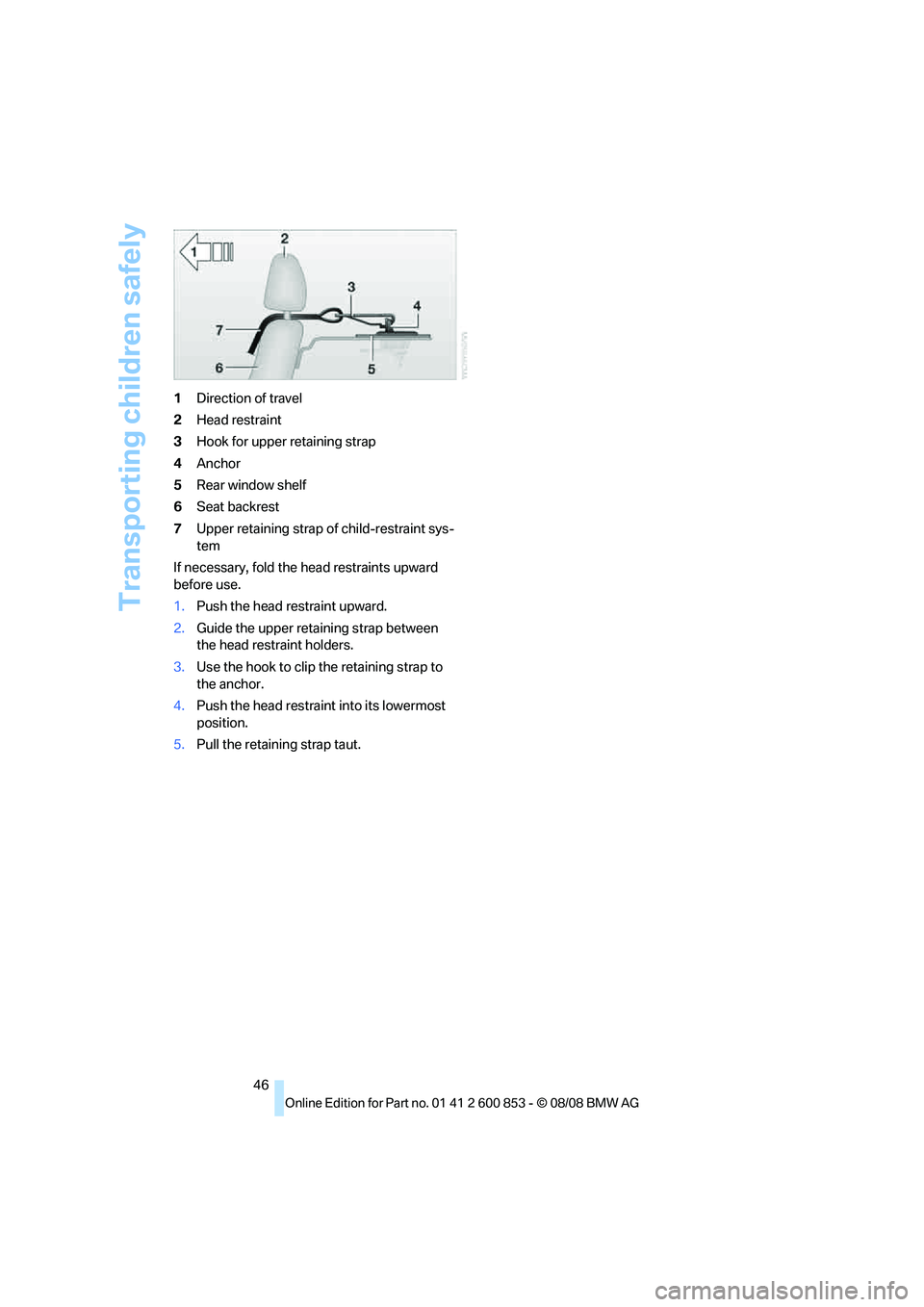
Transporting children safely
46 1Direction of travel
2Head restraint
3Hook for upper retaining strap
4Anchor
5Rear window shelf
6Seat backrest
7Upper retaining strap of child-restraint sys-
tem
If necessary, fold the head restraints upward
before use.
1.Push the head restraint upward.
2.Guide the upper retaining strap between
the head restraint holders.
3.Use the hook to clip the retaining strap to
the anchor.
4.Push the head restraint into its lowermost
position.
5.Pull the retaining strap taut.
Page 74 of 166
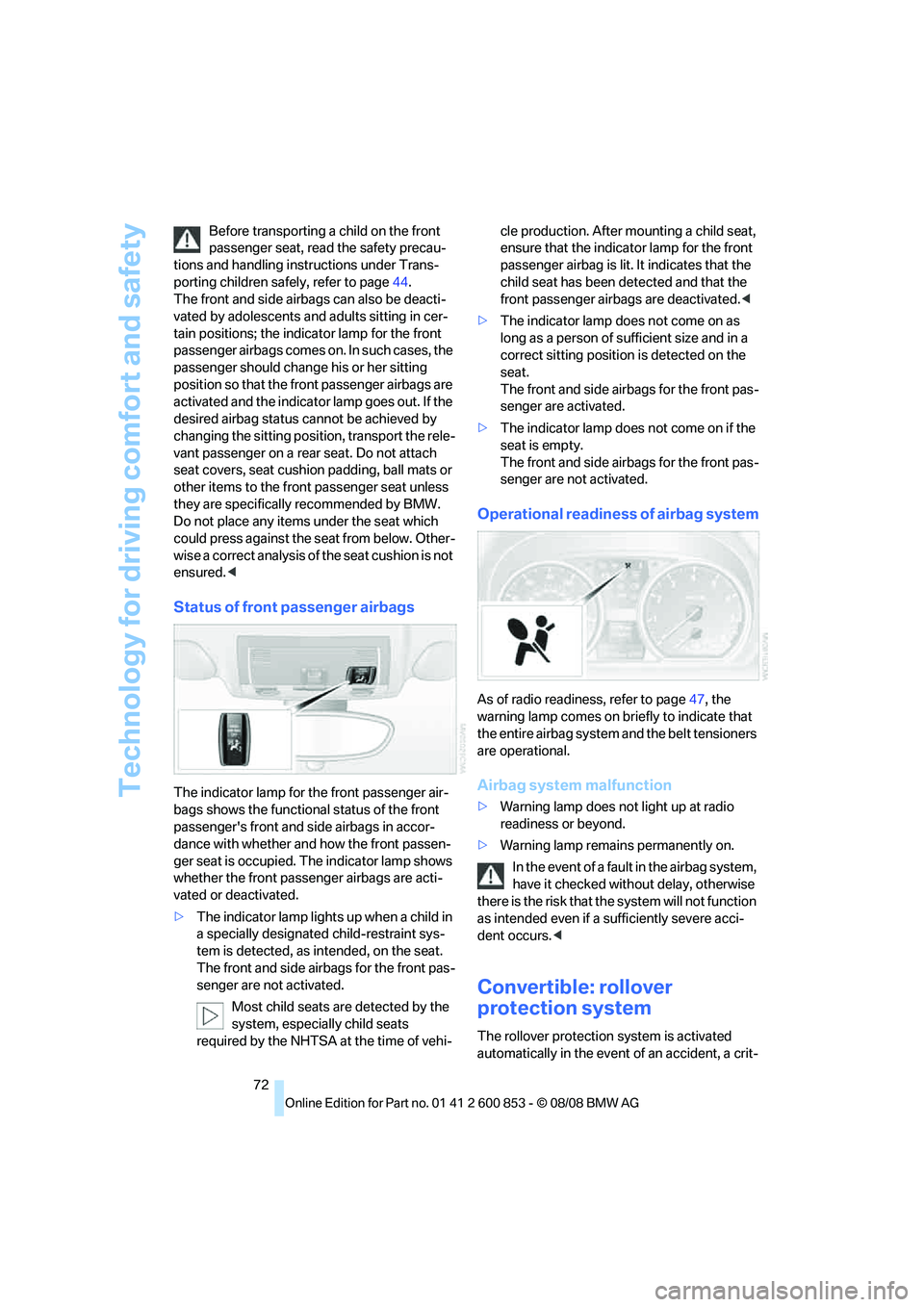
Technology for driving comfort and safety
72 Before transporting a child on the front
passenger seat, read the safety precau-
tions and handling instructions under Trans-
porting children safely, refer to page44.
The front and side airbags can also be deacti-
vated by adolescents and adults sitting in cer-
tain positions; the indicator lamp for the front
passenger airbags comes on. In such cases, the
passenger should change his or her sitting
position so that the front passenger airbags are
activated and the indicator lamp goes out. If the
desired airbag status cannot be achieved by
changing the sitting position, transport the rele-
vant passenger on a rear seat. Do not attach
seat covers, seat cushion padding, ball mats or
other items to the front passenger seat unless
they are specifically recommended by BMW.
Do not place any items under the seat which
could press against the seat from below. Other-
wise a correct analysis of the seat cushion is not
ensured.<
Status of front passenger airbags
The indicator lamp for the front passenger air-
bags shows the functional status of the front
passenger's front and side airbags in accor-
dance with whether and how the front passen-
ger seat is occupied. The indicator lamp shows
whether the front passenger airbags are acti-
vated or deactivated.
>The indicator lamp lights up when a child in
a specially designated child-restraint sys-
tem is detected, as intended, on the seat.
The front and side airbags for the front pas-
senger are not activated.
Most child seats are detected by the
system, especially child seats
required by the NHTSA at the time of vehi-cle production. After mounting a child seat,
ensure that the indicator lamp for the front
passenger airbag is lit. It indicates that the
child seat has been detected and that the
front passenger airbags are deactivated.<
>The indicator lamp does not come on as
long as a person of sufficient size and in a
correct sitting position is detected on the
seat.
The front and side airbags for the front pas-
senger are activated.
>The indicator lamp does not come on if the
seat is empty.
The front and side airbags for the front pas-
senger are not activated.
Operational readiness of airbag system
As of radio readiness, refer to page47, the
warning lamp comes on briefly to indicate that
the entire airbag system and the belt tensioners
are operational.
Airbag system malfunction
>Warning lamp does not light up at radio
readiness or beyond.
>Warning lamp remains permanently on.
In the event of a fault in the airbag system,
have it checked without delay, otherwise
there is the risk that the system will not function
as intended even if a sufficiently severe acci-
dent occurs.<
Convertible: rollover
protection system
The rollover protection system is activated
automatically in the event of an accident, a crit-
Page 155 of 166
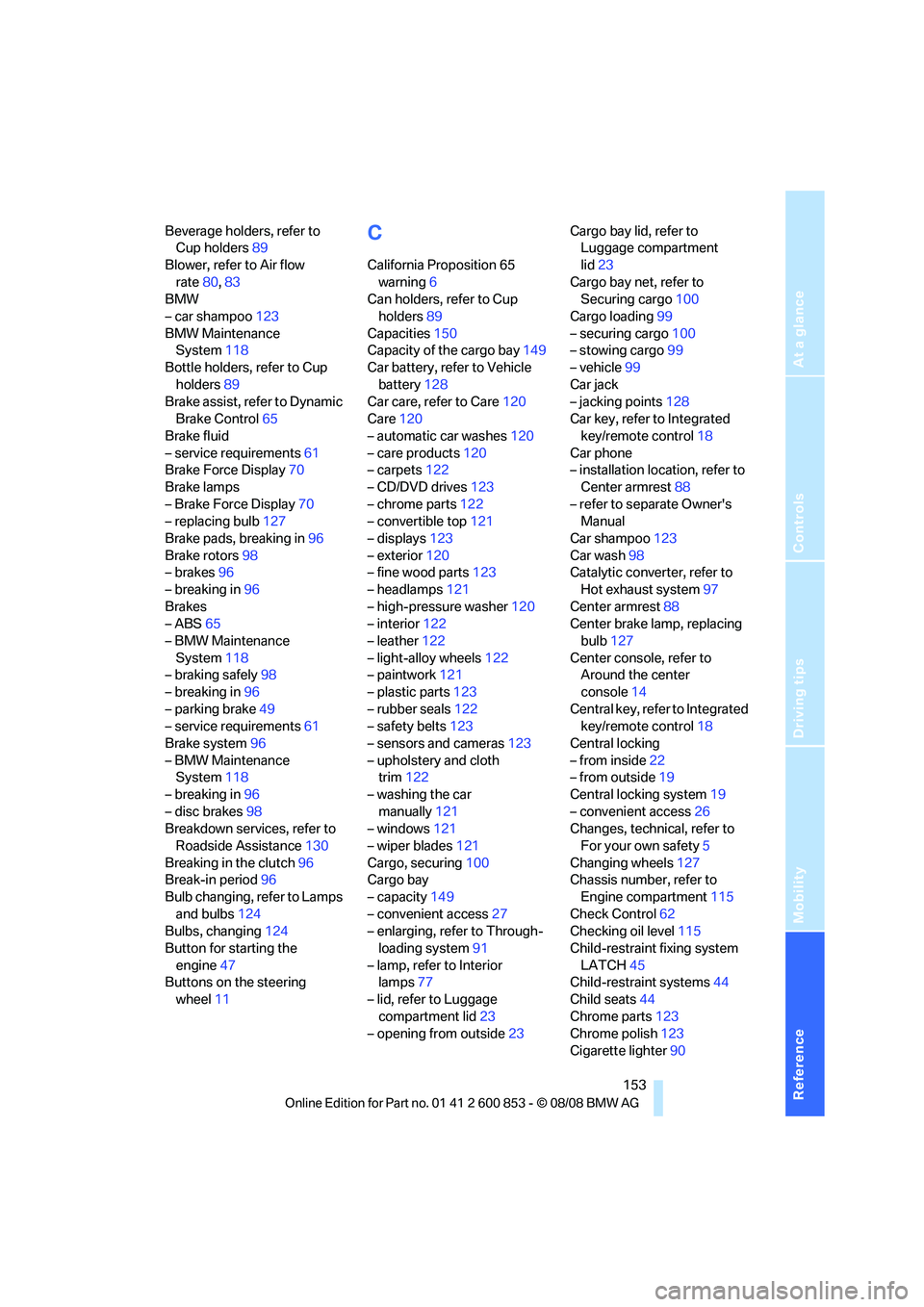
Reference
At a glance
Controls
Driving tips
Mobility
153
Beverage holders, refer to
Cup holders89
Blower, refer to Air flow
rate80,83
BMW
– car shampoo123
BMW Maintenance
System118
Bottle holders, refer to Cup
holders89
Brake assist, refer to Dynamic
Brake Control65
Brake fluid
– service requirements61
Brake Force Display70
Brake lamps
– Brake Force Display70
– replacing bulb127
Brake pads, breaking in96
Brake rotors98
– brakes96
– breaking in96
Brakes
– ABS65
– BMW Maintenance
System118
– braking safely98
– breaking in96
– parking brake49
– service requirements61
Brake system96
– BMW Maintenance
System118
– breaking in96
– disc brakes98
Breakdown services, refer to
Roadside Assistance130
Breaking in the clutch96
Break-in period96
Bulb changing, refer to Lamps
and bulbs124
Bulbs, changing124
Button for starting the
engine47
Buttons on the steering
wheel11C
California Proposition 65
warning6
Can holders, refer to Cup
holders89
Capacities150
Capacity of the cargo bay149
Car battery, refer to Vehicle
battery128
Car care, refer to Care120
Care120
– automatic car washes120
– care products120
– carpets122
– CD/DVD drives123
– chrome parts122
– convertible top121
– displays123
– exterior120
– fine wood parts123
– headlamps121
– high-pressure washer120
– interior122
– leather122
– light-alloy wheels122
– paintwork121
– plastic parts123
– rubber seals122
– safety belts123
– sensors and cameras123
– upholstery and cloth
trim122
– washing the car
manually121
– windows121
– wiper blades121
Cargo, securing100
Cargo bay
– capacity149
– convenient access27
– enlarging, refer to Through-
loading system91
– lamp, refer to Interior
lamps77
– lid, refer to Luggage
compartment lid23
– opening from outside23Cargo bay lid, refer to
Luggage compartment
lid23
Cargo bay net, refer to
Securing cargo100
Cargo loading99
– securing cargo100
– stowing cargo99
– vehicle99
Car jack
– jacking points128
Car key, refer to Integrated
key/remote control
18
Car phone
– installation location, refer to
Center armrest88
– refer to separate Owner's
Manual
Car shampoo123
Car wash98
Catalytic converter, refer to
Hot exhaust system97
Center armrest88
Center brake lamp, replacing
bulb127
Center console, refer to
Around the center
console14
Central key, refer to Integrated
key/remote control18
Central locking
– from inside22
– from outside19
Central locking system19
– convenient access26
Changes, technical, refer to
For your own safety5
Changing wheels127
Chassis number, refer to
Engine compartment115
Check Control62
Checking oil level115
Child-restraint fixing system
LATCH45
Child-restraint systems44
Child seats44
Chrome parts123
Chrome polish123
Cigarette lighter90
Page 159 of 166
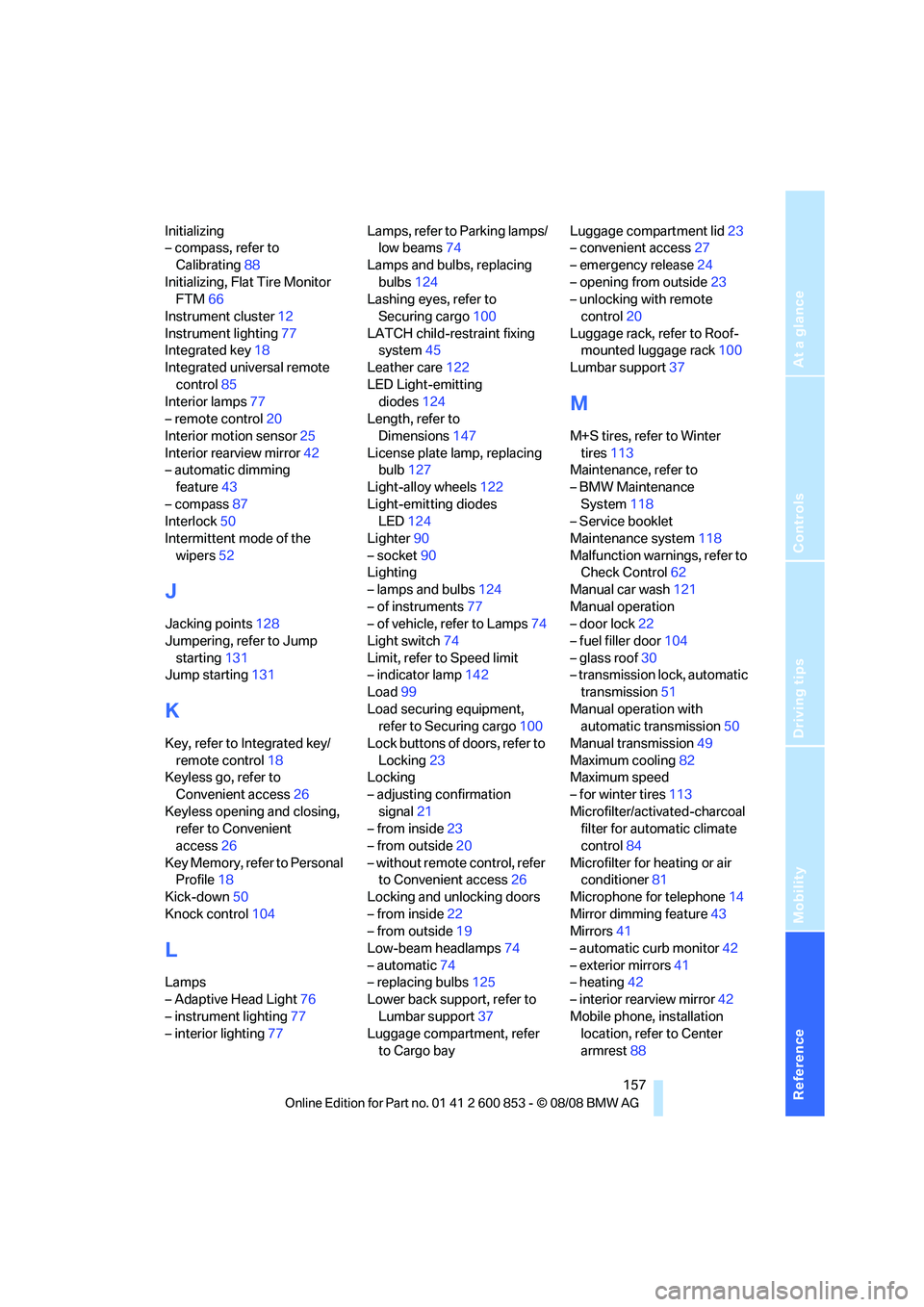
Reference
At a glance
Controls
Driving tips
Mobility
157
Initializing
– compass, refer to
Calibrating88
Initializing, Flat Tire Monitor
FTM66
Instrument cluster12
Instrument lighting77
Integrated key18
Integrated universal remote
control85
Interior lamps77
– remote control20
Interior motion sensor25
Interior rearview mirror42
– automatic dimming
feature43
– compass87
Interlock50
Intermittent mode of the
wipers52
J
Jacking points128
Jumpering, refer to Jump
starting131
Jump starting131
K
Key, refer to Integrated key/
remote control18
Keyless go, refer to
Convenient access26
Keyless opening and closing,
refer to Convenient
access26
Key Memory, refer to Personal
Profile18
Kick-down50
Knock control104
L
Lamps
– Adaptive Head Light76
– instrument lighting77
– interior lighting77Lamps, refer to Parking lamps/
low beams74
Lamps and bulbs, replacing
bulbs124
Lashing eyes, refer to
Securing cargo100
LATCH child-restraint fixing
system45
Leather care122
LED Light-emitting
diodes124
Length, refer to
Dimensions147
License plate lamp, replacing
bulb127
Light-alloy wheels122
Light-emitting diodes
LED124
Lighter90
– socket90
Lighting
– lamps and bulbs124
– of instruments77
– of vehicle, refer to Lamps74
Light switch74
Limit, refer to Speed limit
– indicator lamp142
Load99
Load securing equipment,
refer to Securing cargo100
Lock buttons of doors, refer to
Locking23
Locking
– adjusting confirmation
signal21
– from inside23
– from outside20
– without remote control, refer
to Convenient access26
Locking and unlocking doors
– from inside22
– from outside19
Low-beam headlamps74
– automatic74
– replacing bulbs125
Lower back support, refer to
Lumbar support37
Luggage compartment, refer
to Cargo bayLuggage compartment lid23
– convenient access27
– emergency release24
– opening from outside23
– unlocking with remote
control20
Luggage rack, refer to Roof-
mounted luggage rack100
Lumbar support37
M
M+S tires, refer to Winter
tires113
Maintenance, refer to
– BMW Maintenance
System118
– Service booklet
Maintenance system118
Malfunction warnings, refer to
Check Control62
Manual car wash121
Manual operation
– door lock22
– fuel filler door104
– glass roof30
– transmission lock, automatic
transmission51
Manual operation with
automatic transmission50
Manual transmission49
Maximum cooling82
Maximum speed
– for winter tires113
Microfilter/activated-charcoal
filter for automatic climate
control84
Microfilter for heating or air
conditioner81
Microphone for telephone14
Mirror dimming feature43
Mirrors41
– automatic curb monitor42
– exterior mirrors41
– heating42
– interior rearview mirror42
Mobile phone, installation
location, refer to Center
armrest88